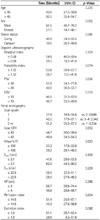1. Tonelli M, Wiebe N, Knoll G, Bello A, Browne S, Jadhav D, et al. Systematic review: kidney transplantation compared with dialysis in clinically relevant outcomes. Am J Transplant. 2011; 11:2093–2109.
2. Al-Jedai A, Alsultan M, Almeshari K, Alshaibani K, Elgamal H, Alkortas D, et al. Cost analysis of kidney transplantation in highly sensitized recipients compared to intermittent maintenance hemodialysis. Ann Transplant. 2012; 17:82–91.
3. Halawa A. The early diagnosis of acute renal graft dysfunction: a challenge we face. The role of novel biomarkers. Ann Transplant. 2011; 16:90–98.
4. Hariharan S, McBride MA, Cherikh WS, Tolleris CB, Bresnahan BA, Johnson CP. Post-transplant renal function in the first year predicts long-term kidney transplant survival. Kidney Int. 2002; 62:311–318.
5. Gourishankar S, Hunsicker LG, Jhangri GS, Cockfield SM, Halloran PF. The stability of the glomerular filtration rate after renal transplantation is improving. J Am Soc Nephrol. 2003; 14:2387–2394.
6. White C, Akbari A, Hussain N, Dinh L, Filler G, Lepage N, et al. Estimating glomerular filtration rate in kidney transplantation: a comparison between serum creatinine and cystatin C-based methods. J Am Soc Nephrol. 2005; 16:3763–3770.
7. Delaney V, Ling BN, Campbell WG, Bourke JE, Fekete PS, O'Brien DP 3rd, et al. Comparison of fine-needle aspiration biopsy, Doppler ultrasound, and radionuclide scintigraphy in the diagnosis of acute allograft dysfunction in renal transplant recipients: sensitivity, specificity, and cost analysis. Nephron. 1993; 63:263–272.
8. Kocabas¸ B, Aktas¸ A, Aras M, Is¸iklar I, Gençoğlu A. Renal scintigraphy findings in allograft recipients with increased resistance index on Doppler sonography. Transplant Proc. 2008; 40:100–103.
9. al-Nahhas AM, Kedar R, Morgan SH, Landells WN, al-Murrani B, Heary T, et al. Cellular versus vascular rejection in transplant kidneys. Correlation of radionuclide and Doppler studies with histology. Nucl Med Commun. 1993; 14:761–765.
10. Isiklar I, Aktas A, Uzuner O, Demirag A, Haberal M. Power Doppler ultrasonography compared with scintigraphy in the diagnosis of renal allograft dysfunction. Transplant Proc. 1999; 31:3330–3331.
11. Brown ED, Chen MY, Wolfman NT, Ott DJ, Watson NE Jr. Complications of renal transplantation: evaluation with US and radionuclide imaging. Radiographics. 2000; 20:607–622.
12. Saracino A, Santarsia G, Latorraca A, Gaudiano V. Early assessment of renal resistance index after kidney transplant can help predict long-term renal function. Nephrol Dial Transplant. 2006; 21:2916–2920.
13. Reinig JW, Gordon L, Frey D, Garrick E, Daniel WT 3rd. Glomerular filtration rate in transplantation patients: estimation of renal function using Tc-99m DTPA. Radiology. 1985; 156:505–507.
14. Heaf JG, Iversen J. Uses and limitations of renal scintigraphy in renal transplantation monitoring. Eur J Nucl Med. 2000; 27:871–879.
15. Baxter GM. Ultrasound of renal transplantation. Clin Radiol. 2001; 56:802–818.
16. Cosgrove DO, Chan KE. Renal transplants: what ultrasound can and cannot do. Ultrasound Q. 2008; 24:77–87. quiz 141-142
17. Nezami N, Tarzamni MK, Argani H, Nourifar M. Doppler ultrasonographic indexes in kidney transplant recipients: its relationship with kidney function. Iran J Kidney Dis. 2007; 1:82–87.
18. Rifkin MD, Needleman L, Pasto ME, Kurtz AB, Foy PM, McGlynn E, et al. Evaluation of renal transplant rejection by duplex Doppler examination: value of the resistive index. AJR Am J Roentgenol. 1987; 148:759–762.
19. Gao J, Rubin JM, Xiang DY, He W, Auh YH, Wang J, et al. Doppler parameters in renal transplant dysfunction: correlations with histopathologic changes. J Ultrasound Med. 2011; 30:169–175.
20. McArthur C, Geddes CC, Baxter GM. Early measurement of pulsatility and resistive indexes: correlation with long-term renal transplant function. Radiology. 2011; 259:278–285.
21. Radermacher J, Mengel M, Ellis S, Stuht S, Hiss M, Schwarz A, et al. The renal arterial resistance index and renal allograft survival. N Engl J Med. 2003; 349:115–124.
22. Naesens M, Heylen L, Lerut E, Claes K, De Wever L, Claus F, et al. Intrarenal resistive index after renal transplantation. N Engl J Med. 2013; 369:1797–1806.
23. Enhesari A, Mardpour S, Makki Z, Mardpour S. Early ultrasound assessment of renal transplantation as the valuable biomarker of long lasting graft survival: a cross-sectional study. Iran J Radiol. 2014; 11:e11492.
24. Gonzalez Molina M, Morales JM, Marcen R, Campistol JM, Oppenheimer F, Serón D, et al. Renal function in patients with cadaveric kidney transplants treated with tacrolimus or cyclosporine. Transplant Proc. 2007; 39:2167–2169.









 PDF
PDF ePub
ePub Citation
Citation Print
Print


 XML Download
XML Download